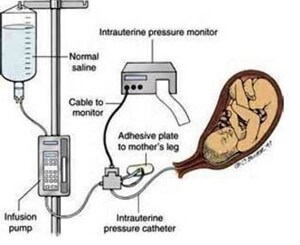Risk factors and causes
Risk factors and causes ( 4 Questions)
A nurse is preparing to perform an amnioinfusion for a client who has oligohydramnios and a cord compression.
Which of the following are appropriate steps for this procedure? (Select all that apply.)
Informed consent is required before performing any invasive procedure, such as amnioinfusion.
An intrauterine pressure catheter (IUPC) is needed to infuse fluid into the amniotic cavity and to monitor the uterine contractions.
Warmed sterile normal saline is the fluid of choice for amnioinfusion, as it mimics the natural amniotic fluid and reduces the risk of infection.
The client’s temperature should be monitored every 15 to 30 minutes, not every 4 hours, to detect any signs of infection or chorioamnionitis.
The fetal heart rate and uterine activity should be assessed continuously to evaluate the fetal well-being and the effectiveness of amnioinfusion.
The correct answer is choice A, B, C and E. Here is why:
• Choice A is correct because informed consent is required before performing any invasive procedure, such as amnioinfusion.
• Choice B is correct because an intrauterine pressure catheter (IUPC) is needed to infuse fluid into the amniotic cavity and to monitor the uterine contractions.
• Choice C is correct because warmed sterile normal saline is the fluid of choice for amnioinfusion, as it mimics the natural amniotic fluid and reduces the risk of infection.
• Choice D is wrong because the client’s temperature should be monitored every 15 to 30 minutes, not every 4 hours, to detect any signs of infection or chorioamnionitis.
• Choice E is correct because the fetal heart rate and uterine activity should be assessed continuously to evaluate the fetal well-being and the effectiveness of amnioinfusion.
Amnioinfusion is a procedure that involves infusing fluid into the amniotic cavity to increase the amniotic fluid volume and to relieve umbilical cord compression. It can be used for clients who have oligohydramnios (low amniotic fluid) and cord compression, which can cause fetal growth restriction and abnormal fetal heart rate patterns. Amnioinfusion can improve the fetal blood flow and oxygenation by reducing the cord compression and variable decelerations.

